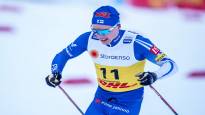There were still a few hours until sunrise at Trondheim’s ski stadium on Friday morning, but there was still enough buzz in the skiing test area. The men went up the hill in a line and went down in pairs. This was the best way to compare the differences between different pairs of skis.
The Finnish maintenance team had been among the first, as the first tests started already after six o’clock.
– It was easier in the morning. Now there was a queue for that, Teemu Lemmettyä smiled.
– We were the first to reach the track. There are a little more people now. Shift numbers would be needed, Olli Ohtonen comment next.
For years, Lemmettylä has been the project manager of Finnish maintenance, who has had the latest information about creams, patterns and equipment at his fingertips. Ohtonen is known Iivo Niskanen as a gold coach, but he also works as the equipment maintenance development manager of the Vuokatti Sports Technology Unit at the University of Jyväskylä.
The two know better than well what the fluoride ban in skiing this season means for athletes and guardians concretely. Several test rounds are needed.
– Enough “arbet”. A tight set is coming, lube chief Heikki Tonteri stated before the sprint qualifying and said that the first preliminary tests have been done before seven o’clock. After that, eight packs of creams were applied and the maintenance team counted creams, patterns and surfaces. After that, the athletes’ preliminary ski tests began.
The Finnish maintenance team was partially on the map in the sprint race, but the men’s race became a passing race. The biggest problem was with the surface pattern of the skis, when the snow stopped between the women’s and men’s qualifying.
“If there was more snowfall, then we would have succeeded with the men as well,” Tonteri said and stated that without the fluoride testing, there would have been time to react to the situation.
– Skis must be tested 40 minutes before qualifying. When the women’s race started, we had the men’s skis in fluoride measurement. There was no way to react to the situation.
The maintenance man’s “dream day” was rough
The Atlantic rain front reached Trondheim on Saturday. It was still cold on Friday, but after that the humidity settled on the track. For many decades there was one clear weapon against the friction caused by moisture: fluorine. Now it is banned and there is no clear substitute for fluoride.
Due to the fluoride ban, the skid data collected by the maintenance teams over many years was thrown into the trash. You didn’t do anything with them anymore, because all this season’s cream products are new and you had to learn them from the very beginning.
The early season competitions have been held in severe frosts, where the relative performance differences between fluorine-free ski creams and fluorine creams have remained moderate. Instead, on Saturday, for the first time in decades, we skied in wet weather without fluoride creams. And this condition was tested for the first time only late Friday night and early Saturday morning.
There was still a combined competition ahead, so each skier has to grease several skis. According to Tonter, a combined competition day is a maintenance man’s “dream day”.
– Fear is expected, but it is also an opportunity, Tonteri said.
After the competition, Tonteri admitted that the day could have been better. The team was on the map in free skiing, but the traditional had big problems. The grip was good, but the skis did not slip.
The situation was best described by Iivo Niskanen, who had planned to break away from the others in the traditional section, but instead he fell out of the top group. He lagged behind the others even on the downhill.
– “Pera” (Perttu Hyvärinen) asked for the last time on top of the hill, what’s up. I said I can’t really grind. Yes, it was all in the game, Niskanen, who finished 24th, was in pain and scolded himself for choosing a ski that was too low.
– My mistake. Another pair would probably have been a better choice, even though the creams were the same. I hope it was because of that and tomorrow will be better. I was in a bit of a hurry now.
“If there is a tendency to stress, then there is stress now”
Tonteri admitted that the athletes’ speeds actually collapsed when they were no longer allowed to put fluorine creams, which repel dirt and moisture brilliantly and at the same time retain their slipperiness, on the bottoms of skis.
– At least a minute and a half, Tonteri calculated the time that the athletes would have saved on the track with fluorine-lubricated helmets.
In the women’s race, this meant around 600 meters, in the men’s race around 700 meters.
– Now the new reality has scratched the surface in the wet weather. Fluoride-free products will certainly develop, but I’m not going to promise that they will achieve the best properties of fluoride creams, Tonteri estimates.
A big part of a top skier’s performance is complete confidence in the equipment. With that, many people are currently applying before the situation stabilizes at some point.
– It certainly affects the mood of many athletes at the moment, but it’s a matter of personality. If there is a tendency to stress anyway, then there is stress now.
The head coach Teemu Pasanen too reminded that this season there have also been differences in equipment, not only lubrication.
– These new rules have made the differences between different instruments bigger, also in other countries. From one weekend to the next, the results are partially completely different. Some succeed and some not so much. The differences have increased.
